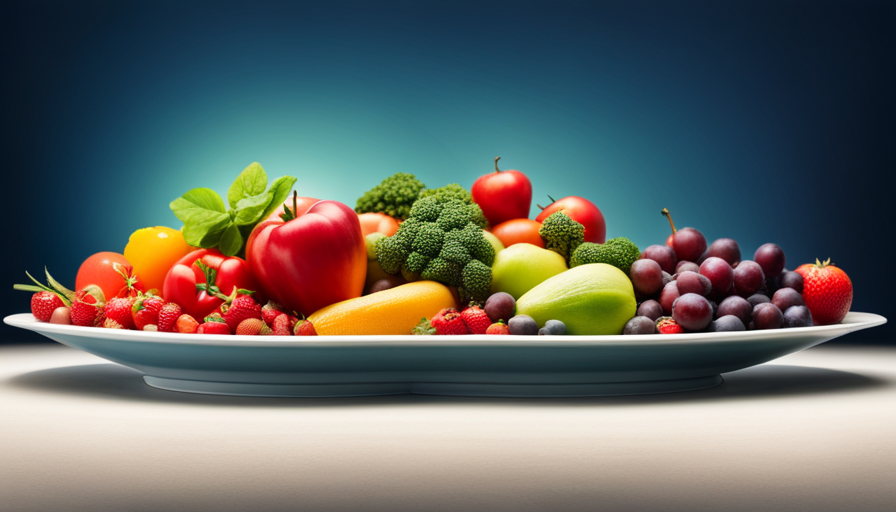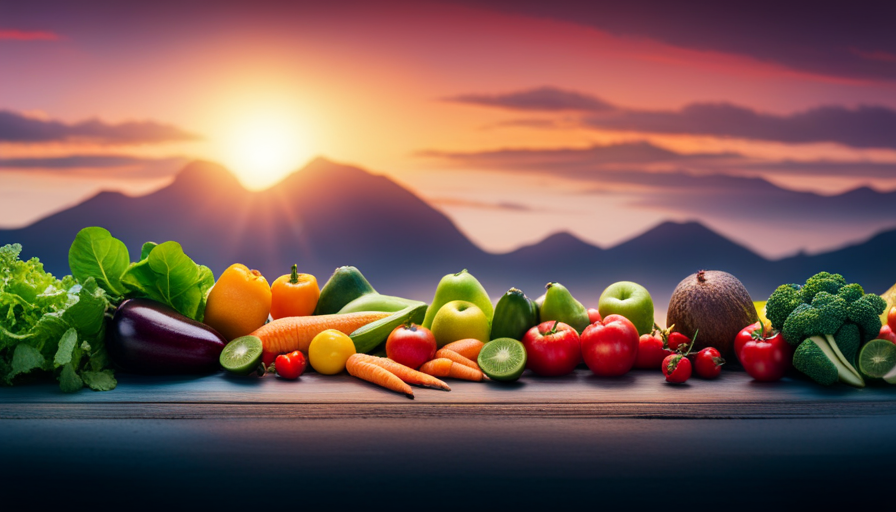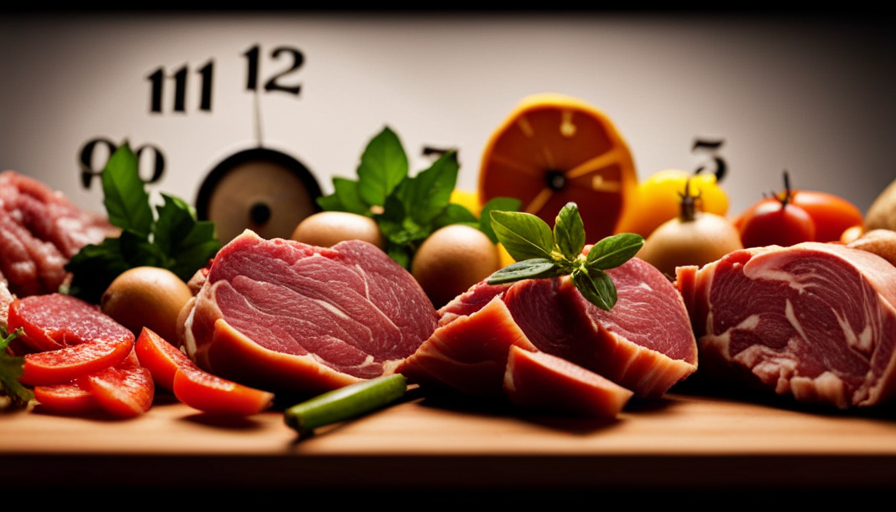I have always been mindful of my health and well-being, which is why I believe in the saying, “You are what you eat.” Switching to a high-carb raw food diet has truly transformed my lifestyle and overall wellness.
Not only does it provide me with the energy and vitality I need to thrive, but it also allows me to enjoy a wide variety of delicious and nutritious foods. However, one question that often comes up is how many calories should you eat on a high-carb raw food diet?
In this article, we’ll explore the importance of calorie intake, the role of carbohydrates in a raw food diet, and provide tips for balancing macronutrients and adjusting caloric intake based on your weight goals and physical activity levels.
So, if you’re ready to dive into the world of high-carb raw food diets, let’s get started!
Key Takeaways
- Caloric intake on a high-carb raw food diet should be based on Basal Metabolic Rate (BMR) and Total Daily Energy Expenditure (TDEE), which can be calculated using age, gender, weight, height, and activity level.
- Adjustments to caloric intake are crucial for weight goals, such as creating a calorie deficit for weight loss or consuming surplus calories for muscle gain.
- Balancing macronutrients is important for optimal health on a high-carb raw food diet, with recommended ratios of 70-80% carbohydrates, 10-15% proteins, and 10-15% fats.
- Nutrient deficiencies may occur on a high-carb raw food diet, so it is important to prioritize key nutrients like protein, calcium, iron, vitamin B12, and omega-3 fatty acids through nutrient-dense foods and, if necessary, supplementation.
Understanding the High-Carb Raw Food Diet
Let’s dive into the world of the high-carb raw food diet and understand what it’s all about! The high-carb raw food diet is a way of eating that focuses on consuming primarily raw fruits, vegetables, and nuts/seeds. This diet is based on the understanding that raw foods contain more nutrients and enzymes than cooked foods, which can support optimal health and wellbeing.
One of the main principles of the high-carb raw food diet is the emphasis on consuming high amounts of carbohydrates from fruits, such as bananas, dates, and melons. These fruits are not only delicious but also provide essential nutrients like vitamins, minerals, and fiber. They are easily digestible and provide a sustainable source of energy throughout the day.
There are several benefits associated with following a high-carb raw food diet. Firstly, it can aid in weight management, as raw fruits and vegetables are low in calories and high in fiber, keeping you feeling full and satisfied. Secondly, this diet can improve digestion and promote regular bowel movements due to the high fiber content. Lastly, it can boost your immune system and provide a wide range of essential nutrients to support overall health.
Understanding the principles and benefits of a high-carb raw food diet sets the foundation for understanding the importance of calorie intake.
The Importance of Calorie Intake
Determining my Basal Metabolic Rate (BMR) and calculating my caloric needs on a high-carb raw food diet are crucial factors in maintaining a healthy lifestyle. By understanding my BMR, I can determine the minimum number of calories my body needs to function at rest.
This knowledge helps me make informed decisions about my calorie intake and ensure that I’m fueling my body properly on a high-carb raw food diet.
Determining Your Basal Metabolic Rate (BMR)
To find out how many calories you should eat on a high-carb raw food diet, imagine calculating your Basal Metabolic Rate (BMR). Your BMR is the number of calories your body needs to perform basic functions like breathing and maintaining body temperature. Determining your metabolic rate is crucial in estimating your caloric needs.
Here’s how you can calculate your BMR:
-
Use the Harris-Benedict equation: This equation takes into account your age, gender, weight, and height to estimate your BMR.
-
Consider your activity level: Once you have your BMR, you can factor in your activity level to determine your total daily energy expenditure (TDEE). This will give you a more accurate estimate of the calories you need.
-
Consult a professional: If you’re unsure about calculating your BMR on your own, it’s always a good idea to seek guidance from a registered dietitian or nutritionist.
By calculating your caloric needs on a high-carb raw food diet, you can ensure that you’re nourishing your body properly and maintaining a healthy weight.
Calculating Your Caloric Needs on a High-Carb Raw Food Diet
Imagine yourself as a human engine, fueling your body with the precise number of calories it needs to thrive on a high-carb raw food lifestyle. Calculating your caloric needs on a high-carb raw food diet is crucial for achieving your weight goals and maintaining optimal health.
To determine your caloric needs, you can use online calculators or consult with a registered dietitian. Factors such as age, gender, height, weight, and activity level should be taken into account. If you’re looking to lose weight, you may need to create a calorie deficit by consuming fewer calories than your body requires. On the other hand, if you want to gain weight, you may need to consume more calories.
It’s important to listen to your body and make adjustments as needed. Understanding how many calories your body needs will help you make informed decisions about your diet.
Now, let’s explore the role of carbohydrates in a raw food diet.
The Role of Carbohydrates in a Raw Food Diet
When following a high-carb raw food diet, you should aim to consume a sufficient amount of carbohydrates to fuel your body and support optimal health. Carbohydrates are the main source of energy for our bodies, and they play a crucial role in a raw food diet. Thankfully, there are plenty of carbohydrate sources available in a raw food diet, such as fruits, vegetables, and sprouted grains.
These foods provide a wide range of nutrients, including vitamins, minerals, and fiber, which are essential for maintaining good health. One important aspect of managing cravings on a high-carb raw food diet is to ensure that you are consuming a variety of carbohydrates. This means including different types of fruits and vegetables in your meals to satisfy your taste buds and prevent boredom. It’s also helpful to experiment with different raw food recipes and techniques to keep your meals interesting and enjoyable.
Carbohydrates are an essential part of a high-carb raw food diet. They provide the energy and nutrients needed for optimal health. By incorporating a variety of carbohydrate sources and managing cravings, you can ensure that you are getting the right amount of carbohydrates to support your body’s needs.
In the next section, we will discuss the importance of balancing macronutrients on a high-carb raw food diet.
Balancing Macronutrients on a High-Carb Raw Food Diet
As you strive for optimal health on a high-carb raw food diet, it’s important to find a balance between macronutrients to fuel your body effectively. Calculating macronutrient ratios is crucial in ensuring that you are getting the right amount of carbohydrates, proteins, and fats. While carbohydrates are the main source of energy in a high-carb raw food diet, it’s important to also include adequate amounts of protein and healthy fats to meet your body’s needs.
To help you understand the importance of balancing macronutrients, consider the following table:
| Macronutrient | Calories per gram | Recommended Ratio |
|---|---|---|
| Carbohydrates | 4 | 70-80% of total calories |
| Proteins | 4 | 10-15% of total calories |
| Fats | 9 | 10-15% of total calories |
By following these recommended ratios, you can ensure that you are providing your body with the necessary nutrients while maintaining a high-carb raw food diet. However, it’s important to note that a high-carb raw food diet may potentially lead to nutrient deficiencies, particularly in essential fatty acids, vitamin B12, iron, and calcium. Therefore, it’s crucial to be mindful of incorporating nutrient-dense foods and, if needed, consider supplementation to prevent deficiencies.
Transitioning into the next section about adjusting caloric intake for weight goals, it’s important to note that finding the right balance of macronutrients is also essential in achieving your desired weight.
Adjusting Caloric Intake for Weight Goals
To achieve your desired weight, it’s crucial to adjust your caloric intake while maintaining a balance of macronutrients. When it comes to a high-carb raw food diet, adjusting caloric intake is essential for both muscle gain and weight loss.
If your goal is to build muscle, you’ll need to consume more calories than you burn. This surplus provides the energy necessary for muscle growth and repair. On the other hand, if you’re aiming for weight loss, a calorie deficit is needed. By consuming fewer calories than your body requires, it will tap into its stored fat for energy, resulting in weight loss over time.
To determine the appropriate caloric intake, it’s helpful to calculate your Basal Metabolic Rate (BMR). This is the number of calories your body needs to maintain its current weight at rest. From there, you can adjust your intake based on your weight goals. For muscle gain, aim to consume around 250-500 calories above your BMR, while for weight loss, a deficit of 250-500 calories below your BMR is recommended.
Listening to your body’s hunger and fullness cues also plays a crucial role in adjusting your caloric intake. Pay attention to how your body feels after meals – are you satisfied or overly full? By tuning in to these cues, you can make adjustments as needed to find the right balance for your body.
Transitioning into the subsequent section about ‘listening to your body’s hunger and fullness cues’, it’s important to find a balance that works for you without feeling restricted.
Listening to Your Body’s Hunger and Fullness Cues
Listen closely to your body’s hunger and fullness cues to find the perfect balance for your unique needs and goals. Body awareness and mindful eating are key components of a high-carb raw food diet. When you tune in to your body’s signals, you can determine how much food you truly need and avoid overeating.
The first step in listening to your body’s cues is to pay attention to physical sensations. Take note of your hunger level before and after meals. Are you eating because you’re truly hungry, or is it due to boredom or emotional reasons? Mindfully eating means being present in the moment and savoring each bite. It allows you to fully experience the taste, texture, and satisfaction of the food you’re consuming.
Another important aspect of body awareness is recognizing feelings of fullness. It takes time for your brain to register that your stomach is full, so eat slowly and give yourself a chance to feel satisfied before reaching for seconds. Remember, it’s okay to leave food on your plate if you’re no longer hungry.
By listening to your body’s hunger and fullness cues, you can ensure that you’re providing it with the right amount of calories on a high-carb raw food diet. This approach promotes a healthy relationship with food and helps you maintain a balanced weight.
In the next section, we’ll explore how monitoring your nutrient intake can further support your goals without making you feel deprived.
Monitoring Your Nutrient Intake
When following a raw food diet, it’s important to focus on key nutrients to ensure proper nutrition. These key nutrients include protein, calcium, iron, vitamin B12, and omega-3 fatty acids.
To ensure I’m meeting my nutrient needs, I find it helpful to use food tracking apps that provide detailed information on the nutrient content of raw foods. By tracking my intake, I can make adjustments to my diet to ensure I’m getting all the necessary nutrients for optimal health.
Key Nutrients to Focus on in a Raw Food Diet
Make sure you prioritize key nutrients like vitamins, minerals, and antioxidants in your raw food diet to nourish your body and unleash its full potential.
A raw food diet can provide numerous health benefits, but it’s important to be mindful of potential nutrient deficiencies. Here are five key nutrients to focus on in a raw food diet:
-
Protein: Incorporate plant-based sources like nuts, seeds, and legumes to meet your protein needs.
-
Iron: Include iron-rich foods such as dark leafy greens, dried fruits, and spirulina to prevent anemia.
-
Calcium: Consume calcium-rich foods like kale, broccoli, and sesame seeds to support bone health.
-
Vitamin B12: Consider fortified foods or a supplement to ensure adequate B12 intake.
-
Omega-3 fatty acids: Incorporate flaxseeds, chia seeds, and walnuts to maintain optimal brain and heart health.
By prioritizing these key nutrients, you can optimize your raw food diet for overall well-being.
Transitioning into the subsequent section, using food tracking apps can help ensure proper nutrition without feeling overwhelmed.
Using Food Tracking Apps to Ensure Proper Nutrition
Using food tracking apps can help you ensure that you’re getting all the necessary nutrients in your raw food diet. Food diary benefits, tracking apps, provide a convenient way to monitor your nutrient intake and identify any potential deficiencies.
These apps allow you to input the foods you eat and track the macronutrients, vitamins, and minerals they contain. By regularly monitoring your food intake, you can identify any nutrient gaps and make adjustments to your diet accordingly. This can help prevent nutrient deficiencies and promote optimal health on a high-carb raw food diet.
Additionally, food tracking apps can provide valuable insights into your eating habits and help you make informed decisions about your diet. With the information provided by these apps, you can ensure that you are meeting your nutritional needs and achieving your health goals.
Transitioning into meal planning and preparation tips, let’s explore some strategies to help you make the most of your raw food diet.
Meal Planning and Preparation Tips
To whip up a scrumptious batch of raw food meals, try incorporating a variety of colorful fruits and veggies into your high-carb diet. Meal prep and grocery shopping are crucial steps in ensuring that you have all the necessary ingredients on hand to create delicious and nutritious meals.
When meal planning, it’s important to consider the nutritional needs of your body and choose foods that provide a balance of macronutrients. Stock up on a variety of fruits and vegetables, including leafy greens, berries, and citrus fruits, to ensure a wide range of vitamins and minerals. Additionally, include sources of healthy fats such as avocados, nuts, and seeds to provide satiety and support nutrient absorption.
When it comes to meal preparation, it can be helpful to chop, wash, and store your fruits and vegetables in advance. This not only saves time but also makes it easier to grab a quick and healthy snack or throw together a meal. Consider investing in quality food storage containers and organizing your fridge and pantry to make meal prep a breeze.
As you transition into the subsequent section about adjusting caloric intake for physical activity, it’s important to remember that meal planning and preparation are just the first steps in maintaining a high-carb raw food diet. By being mindful of your physical activity level and adjusting your caloric intake accordingly, you can ensure that you’re fueling your body properly and supporting your overall health and wellbeing.
Adjusting Caloric Intake for Physical Activity
When following a high-carb raw food diet, it’s important to adjust your caloric intake to fuel your workouts effectively. As someone who exercises regularly, I’ve found that increasing my caloric intake before and after workouts helps me stay energized and perform at my best.
Additionally, replenishing energy after exercise is crucial for muscle recovery and overall recovery.
Fueling Your Workouts on a High-Carb Raw Food Diet
Fuel up your workouts with the right amount of calories on a high-carb raw food diet to maximize your performance and achieve your fitness goals. When following a high-carb raw food diet, it’s important to ensure that you are consuming enough calories to fuel your workouts and provide your body with the energy it needs. To determine your caloric needs, consider factors such as your weight, activity level, and goals. Aiming for a balance of macronutrients, including carbohydrates, protein, and healthy fats, can help support your workouts and overall health.
To give you an idea of the caloric needs for different types of workouts, here’s a table:
| Type of Workout | Caloric Needs |
|---|---|
| Cardiovascular | 300-500 |
| Strength Training | 400-600 |
| High-Intensity | 500-700 |
| Endurance | 600-800 |
By fueling your workouts with the right amount of calories, you can optimize your performance and reach your fitness goals on a high-carb raw food diet. Now, let’s explore how to replenish energy after exercise.
Replenishing Energy After Exercise
After an intense workout on a high-carb raw food diet, it’s crucial to replenish your energy levels for optimal post-exercise recovery. Consuming the right nutrients is key to this process.
Replenishing energy after exercise is essential to restore glycogen stores in your muscles and provide the necessary nutrients for muscle repair and growth. It is recommended to consume a combination of carbohydrates and protein within 30 minutes to an hour after your workout to maximize recovery. This can include options such as a fruit smoothie with added plant-based protein powder or a raw salad with plenty of carbohydrates and a protein source like nuts or seeds.
Ensuring you replenish your energy levels after exercise will help you recover faster and perform better in your next workout.
Transitioning into the subsequent section about consulting with a nutritionist or dietitian, it is important to seek professional guidance to personalize your high-carb raw food diet for optimal results.
Consulting with a Nutritionist or Dietitian
Consulting with a nutritionist or dietitian can be a game-changer when it comes to finding the right balance of calories on a high-carb raw food diet. These professionals provide valuable nutritional guidance and can help create personalized meal plans that meet individual needs and goals.
Here are three ways a nutritionist or dietitian can assist in optimizing calorie intake:
-
Assessing energy requirements: A nutritionist or dietitian can determine the appropriate number of calories needed to support daily activities and exercise. They consider factors such as age, gender, weight, activity level, and specific dietary preferences to calculate an individual’s energy needs.
-
Developing personalized meal plans: With their expertise, nutritionists or dietitians can create customized meal plans that ensure adequate calorie intake while adhering to a high-carb raw food diet. These plans incorporate a variety of nutrient-dense foods, such as fruits, vegetables, whole grains, and legumes, to provide essential vitamins, minerals, and macronutrients.
-
Monitoring progress and making adjustments: Regular consultations with a nutritionist or dietitian allow for ongoing monitoring and adjustments to calorie intake. They can help track progress, address challenges, and make necessary modifications to ensure optimal energy levels and overall health.
By working with a nutritionist or dietitian, individuals following a high-carb raw food diet can receive expert guidance and support in achieving their calorie goals while maintaining a balanced and nutritious eating plan.
Frequently Asked Questions
Can I still consume fats and proteins on a high-carb raw food diet?
Yes, you can still consume fats and proteins on a high-carb raw food diet. While the focus is on carbohydrates, incorporating healthy sources of fats and proteins can provide important benefits. Fats help with nutrient absorption and provide energy, while proteins are essential for building and repairing tissues.
Including sources like avocados, nuts, seeds, and legumes can help ensure a well-rounded diet. It’s important to find a balance that works for you and meets your nutritional needs.
Are there any specific foods I should avoid on a high-carb raw food diet?
When following a high-carb raw food diet, it’s important to be mindful of the specific foods to avoid. These can include processed foods, refined sugars, and unhealthy fats. By eliminating these foods, you can reap the benefits of this diet, such as improved digestion, increased energy levels, and better overall health.
It’s important to focus on consuming whole, unprocessed fruits, vegetables, and grains to ensure you’re getting all the essential nutrients your body needs.
How can I ensure I am getting enough nutrients on a high-carb raw food diet?
Getting enough nutrients on a high-carb raw food diet is crucial for maintaining a balanced diet. To ensure this, I focus on consuming a variety of fruits, vegetables, nuts, and seeds. These foods are rich in essential vitamins, minerals, and antioxidants.
I also pay attention to my protein intake by including sources like sprouted legumes and leafy greens. Additionally, I make sure to get enough healthy fats from sources like avocados and coconut.
Can I eat cooked foods occasionally on a high-carb raw food diet?
Yes, you can occasionally eat cooked foods on a high-carb raw food diet. While the main focus is on consuming raw, plant-based foods, incorporating some cooked foods can provide variety and flexibility. However, it’s important to note that cooking can reduce the nutrient content of foods.
The benefits of a high-carb raw food diet include increased intake of fruits, vegetables, and fiber, which can support overall health and weight management.
Is it necessary to consult with a nutritionist or dietitian before starting a high-carb raw food diet?
It’s highly recommended to consult with a nutritionist or dietitian before starting a high-carb raw food diet. They can provide valuable guidance and ensure that you’re meeting your nutritional needs.
While there are several benefits to this diet, such as increased fiber intake and a focus on whole, unprocessed foods, there are also potential drawbacks. These may include nutrient deficiencies and difficulty in meeting calorie needs, which is why professional advice is crucial for a safe and balanced approach.
What are the recommended calorie intake guidelines for a high-carb raw food diet?
When following a high-carb raw food diet, the recommended raw food diet calorie count is around 2,000 to 2,500 calories per day for women and 2,500 to 3,000 calories per day for men. It’s important to focus on consuming nutrient-dense foods to meet your calorie needs while maintaining a balanced diet.
Conclusion
In conclusion, when following a high-carb raw food diet, it’s important to understand the role of calorie intake in maintaining a healthy weight. By balancing macronutrients and adjusting caloric intake based on weight goals and physical activity levels, individuals can ensure they’re getting the necessary energy while still benefiting from the nutrient-rich raw foods.
Monitoring nutrient intake and seeking guidance from a nutritionist or dietitian can further enhance the effectiveness of this diet. So, if you’re looking for a way to boost your health and energy levels, give the high-carb raw food diet a try!










